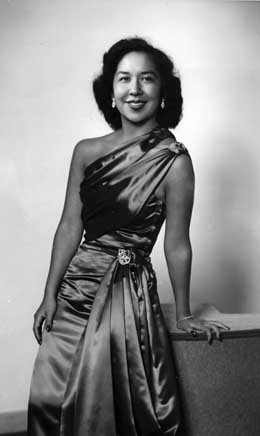On May 9, 1952, Maria Georgina Wyatalute Sneatlum (1928-2007) sings in a student recital at the New England Conservatory of Music, one of many she will perform in the Boston area and in Seattle and Everett, Washington, in the following months. Far from her Tulalip, Washington, home that day, Maria brings many intensive years of study to the occasion.
Talent Discovered and Nurtured
Even as a child of 7 or 8 years old, Maria Sneatlum impressed those who heard her singing in the children’s choir at Tulalip’s Mission of St. Anne’s. Clearly she had an outstanding voice and stage presence. By the time she was a teenager, Maria regularly performed solos at the church, her voice maturing as a strong mezzo-contralto. A church member sponsored Maria in voice lessons and she began studying with music teachers Verna and Bruno Mailer whose studio was in Everett (2919 Wetmore Avenue). For a time Maria lived in the Mailer home at Naketa Beach (Mukilteo) and was given free voice lessons. Bruno Mailer was a violinist with the Seattle Symphony and he coached Maria in the classics including Bach, Beethoven, Brahms, Handel, and Hayden as well as giving her language instruction in French, Italian, German, and Spanish.
Maria also spoke Lushootseed, the Tulalips’ native tongue. Born September 29, 1928, to George and Amelia Snyder Sneatlum, she spent her early years at Tulalip and graduated from Marysville High School in 1949.
A Chance at Fame
Maria pursued intensive voice training and in the early 1950s received a scholarship to study at the New England Conservatory of Music. Here she became a pupil of Frederick Jagel, a composer and well-known figure in the opera world at that time. On May 9, 1952, Maria performed in a Boston recital, singing composer Hugo Wolf’s um Mitternacht and Rossini’s Aria from Semiramide.
But the geographic distance between Tulalip and Boston made her progress difficult. To pay for her travel, Maria gave regular performances in Everett and Seattle, adding to her student performances in Boston. This rigorous schedule continued for about four years. Maria then auditioned and was hired to sing with a church in Worcester, Massachusetts, and she continued to balance work, school, and performances, often commuting by bus.
Perhaps the stress took its toll: Maria became ill and was diagnosed with tubercular meningitis (Mycobacterium tuberculosis), a disease that had taken the life of her brother two years earlier. Maria remained in a coma for several months. New medications and treatment available in the Boston area at the time were credited with saving her life. Maria was transferred to Tacoma’s Cushman Hospital where she convalesced for six months but recovery would take many years more. And although she survived, she no longer could sing and had problems with equilibrium.
Never bitter about what might have been, Marie lived a happy but more common life and died on April 25, 2007, at her home in Seattle. In an interview in 1994, Maria gave the following advice: “Don’t give up. Anything that’s worthwhile isn’t just going to drop into your lap. It will take sacrifice, hard work and lots of patience. Keep your dreams focused. Keep on keeping on” (
See-Yaht-Sub,
1994).

